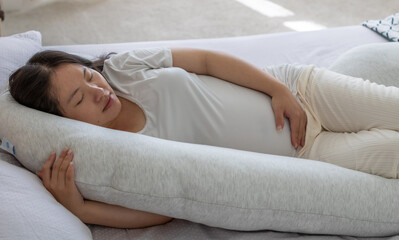Pregnancy is an incredible journey, but it comes with its fair share of discomforts. Throughout history, expecting mothers have sought ways to ease these aches and pains, especially when it comes to getting a good night's sleep. Pregnancy pillows are one of the most popular solutions today.
Designed to support a pregnant woman's body, these pillows help alleviate back pain, improve sleep quality, and provide much-needed comfort. In this article, we will explore the fascinating evolution of pregnancy pillows, from traditional methods used by our ancestors to the innovative designs and materials of the modern era.
Traditional Methods
Ancient Practices
Long before modern pregnancy pillows, expecting mothers found creative ways to ease their discomfort. In ancient times, women used simple but effective methods to find comfort. They often used natural materials like straw, leaves, and animal skins to create makeshift cushions and supports. These materials were readily available and provided the necessary softness and support for a growing belly.
Women would also arrange these materials to support their backs and sides while sleeping. Sometimes, they would use rolled-up cloths or small sacks filled with grains to create support for their bodies, similar to how we use pillows today. These early methods were basic, but they helped provide relief during pregnancy.
Cultural Variations
Different cultures around the world had their unique approaches to supporting pregnant women. For example, in some Asian cultures, women used bolsters—long, narrow pillows—to support their bodies. These bolsters were filled with cotton or other soft materials and were placed under the legs or along the back for added comfort.
In Africa, pregnant women sometimes used woven mats and blankets to create a supportive sleeping surface. They would layer these materials to cushion their bodies and relieve pressure points. Similarly, in Native American cultures, women used animal hides and furs to create soft, comfortable sleeping areas that helped them rest more easily.
Early Pregnancy Pillows
19th and Early 20th Century
In the 19th and early 20th centuries, pregnancy pillows began to take a more recognizable form. These early pillows were simple and functional, designed to provide support for the growing bellies of pregnant women. Often, they were made from basic materials like cotton or wool and stuffed with feathers or down. The designs were straightforward, usually rectangular or wedge-shaped, to fit comfortably under the belly or between the knees.
Mothers appreciated these early pillows for the relief they provided, helping to alleviate back pain and improve sleep. Even though the materials and designs were basic, they marked a significant step forward in providing comfort during pregnancy.
Mid-20th Century
After World War II, the design of pregnancy pillows began to evolve rapidly. Medical advancements and a better understanding of maternal health influenced these changes. During this time, new materials like foam and synthetic fibers were introduced, which allowed for more diverse and supportive designs.
Pregnancy pillows became more ergonomic, with shapes that followed the natural curves of the body. The U-shaped and C-shaped designs that are popular today started to emerge. These shapes provided more comprehensive support, not just for the belly, but also for the back, hips, and legs. This period also saw the introduction of adjustable pillows, which could be customized to meet the specific needs of each woman.
These innovations greatly improved the comfort and well-being of pregnant women, making it easier for them to get the rest they needed.
Modern Innovations
Materials and Technology
Today, pregnancy pillows have come a long way, thanks to advanced materials and technology. Memory foam, microbeads, and hypoallergenic materials have revolutionized comfort. Memory foam molds to the body, providing personalized support, while microbeads allow for flexibility and easy adjustment. Hypoallergenic materials ensure that even moms with allergies can rest comfortably.
Technological advancements have also improved the manufacturing process, making these pillows more durable and adaptable to different needs.
Ergonomic Designs
Modern pregnancy pillows come in various shapes to suit different needs. The C-shaped pillow wraps around the body, supporting the back, belly, and legs. The U-shaped pillow offers full-body support, perfect for those who like to switch sides while sleeping. Wedge pillows are compact and versatile, ideal for targeted support under the belly or back.
Each design caters to different stages of pregnancy and sleeping positions, helping moms find the perfect fit for their comfort.
Specialized Features
Innovations have brought specialized features like adjustable firmness, cooling gels, and multi-functional designs. Adjustable firmness allows moms to customize their pillow's support level. Cooling gels help regulate body temperature, providing a cooler sleep experience. Multi-functional pillows can be used during and after pregnancy, serving as nursing pillows or general support cushions.
Impact on Maternal Health
Comfort and Sleep Quality
Modern pregnancy pillows significantly improve comfort and sleep quality for expecting mothers. Research shows that using these pillows can reduce back and hip pain, leading to better rest. Many moms rave about their experiences, sharing testimonials about how pregnancy pillows have helped them sleep soundly through the night.
Postpartum Uses
These pillows aren't just for pregnancy. After childbirth, they can be used for postpartum support. They provide great help during nursing and can continue to offer comfort and relief from aches. Long-term, they contribute to better health by promoting good posture and reducing strain.
Future Trends
Sustainability
As awareness about environmental issues grows, there's a trend towards eco-friendly pregnancy pillows. Manufacturers are using sustainable materials and processes, ensuring both mom and baby benefit from non-toxic, environmentally friendly products.
Smart Pillows
The future might bring smart pregnancy pillows. Imagine pillows that can monitor your sleep patterns, adjust firmness automatically, or even have built-in cooling and heating features. These innovations could take comfort and support to the next level.

